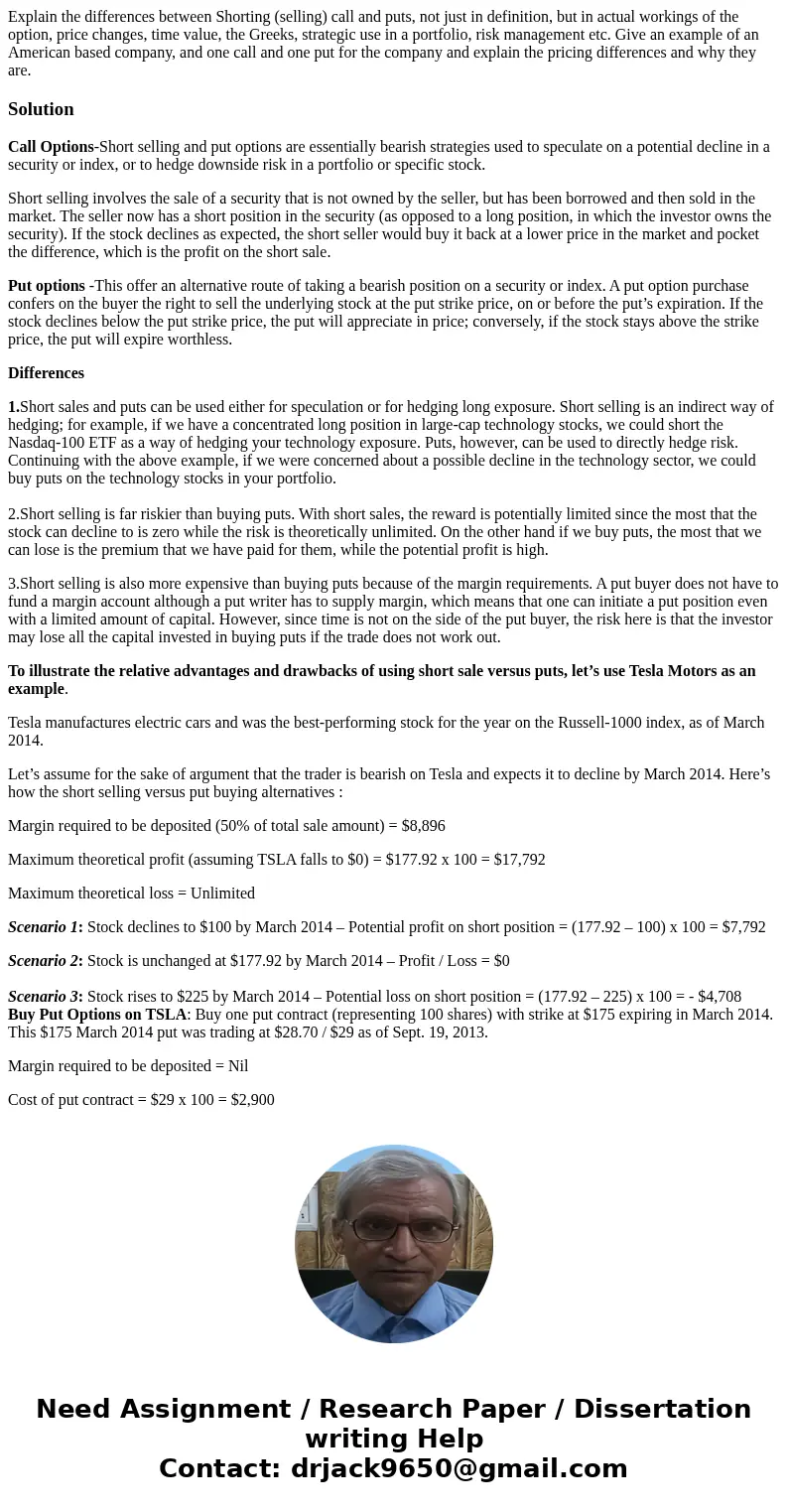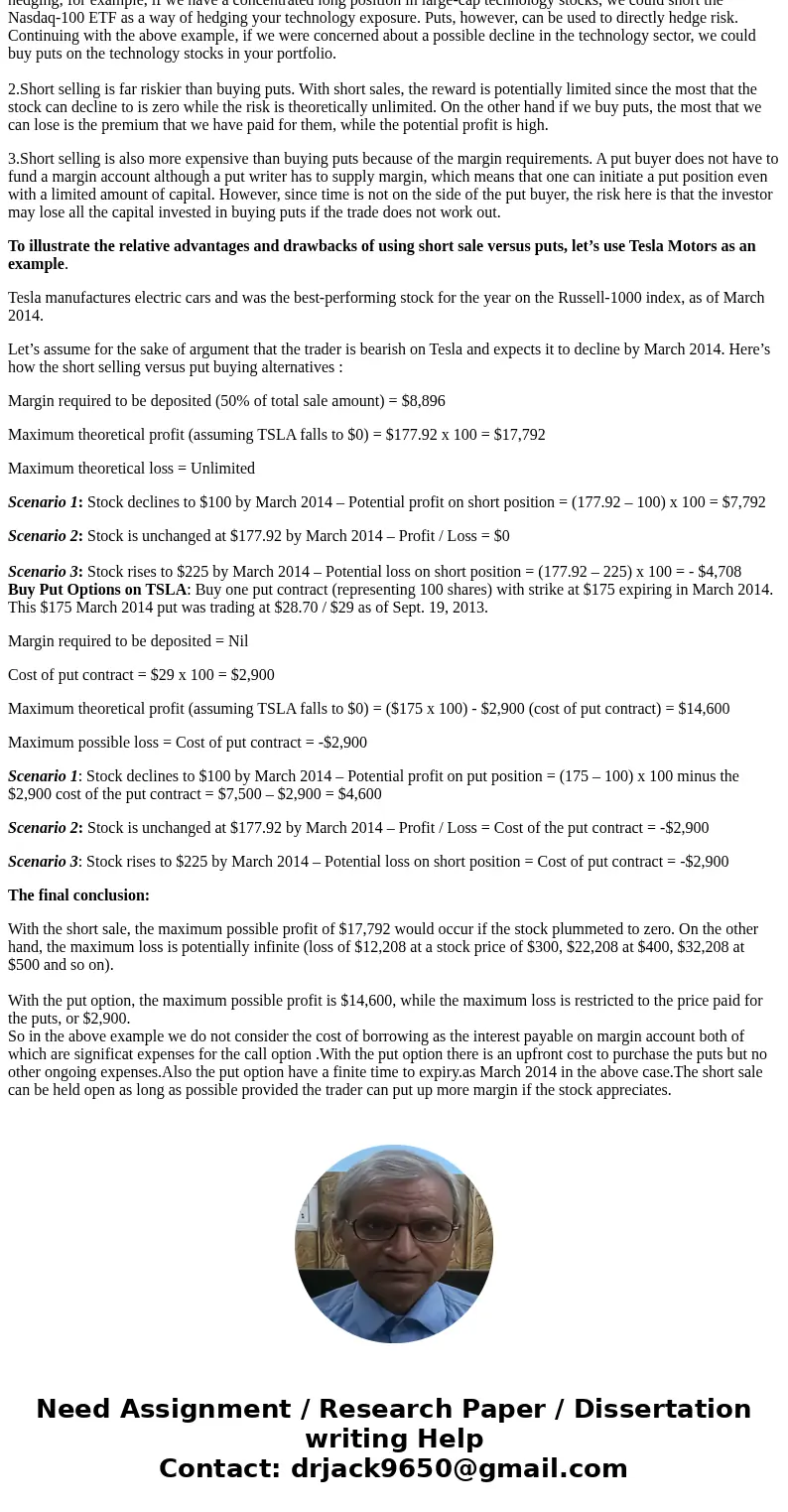Explain the differences between Shorting selling call and pu
Explain the differences between Shorting (selling) call and puts, not just in definition, but in actual workings of the option, price changes, time value, the Greeks, strategic use in a portfolio, risk management etc. Give an example of an American based company, and one call and one put for the company and explain the pricing differences and why they are.
Solution
Call Options-Short selling and put options are essentially bearish strategies used to speculate on a potential decline in a security or index, or to hedge downside risk in a portfolio or specific stock.
Short selling involves the sale of a security that is not owned by the seller, but has been borrowed and then sold in the market. The seller now has a short position in the security (as opposed to a long position, in which the investor owns the security). If the stock declines as expected, the short seller would buy it back at a lower price in the market and pocket the difference, which is the profit on the short sale.
Put options -This offer an alternative route of taking a bearish position on a security or index. A put option purchase confers on the buyer the right to sell the underlying stock at the put strike price, on or before the put’s expiration. If the stock declines below the put strike price, the put will appreciate in price; conversely, if the stock stays above the strike price, the put will expire worthless.
Differences
1.Short sales and puts can be used either for speculation or for hedging long exposure. Short selling is an indirect way of hedging; for example, if we have a concentrated long position in large-cap technology stocks, we could short the Nasdaq-100 ETF as a way of hedging your technology exposure. Puts, however, can be used to directly hedge risk. Continuing with the above example, if we were concerned about a possible decline in the technology sector, we could buy puts on the technology stocks in your portfolio.
2.Short selling is far riskier than buying puts. With short sales, the reward is potentially limited since the most that the stock can decline to is zero while the risk is theoretically unlimited. On the other hand if we buy puts, the most that we can lose is the premium that we have paid for them, while the potential profit is high.
3.Short selling is also more expensive than buying puts because of the margin requirements. A put buyer does not have to fund a margin account although a put writer has to supply margin, which means that one can initiate a put position even with a limited amount of capital. However, since time is not on the side of the put buyer, the risk here is that the investor may lose all the capital invested in buying puts if the trade does not work out.
To illustrate the relative advantages and drawbacks of using short sale versus puts, let’s use Tesla Motors as an example.
Tesla manufactures electric cars and was the best-performing stock for the year on the Russell-1000 index, as of March 2014.
Let’s assume for the sake of argument that the trader is bearish on Tesla and expects it to decline by March 2014. Here’s how the short selling versus put buying alternatives :
Margin required to be deposited (50% of total sale amount) = $8,896
Maximum theoretical profit (assuming TSLA falls to $0) = $177.92 x 100 = $17,792
Maximum theoretical loss = Unlimited
Scenario 1: Stock declines to $100 by March 2014 – Potential profit on short position = (177.92 – 100) x 100 = $7,792
Scenario 2: Stock is unchanged at $177.92 by March 2014 – Profit / Loss = $0
Scenario 3: Stock rises to $225 by March 2014 – Potential loss on short position = (177.92 – 225) x 100 = - $4,708
Buy Put Options on TSLA: Buy one put contract (representing 100 shares) with strike at $175 expiring in March 2014. This $175 March 2014 put was trading at $28.70 / $29 as of Sept. 19, 2013.
Margin required to be deposited = Nil
Cost of put contract = $29 x 100 = $2,900
Maximum theoretical profit (assuming TSLA falls to $0) = ($175 x 100) - $2,900 (cost of put contract) = $14,600
Maximum possible loss = Cost of put contract = -$2,900
Scenario 1: Stock declines to $100 by March 2014 – Potential profit on put position = (175 – 100) x 100 minus the $2,900 cost of the put contract = $7,500 – $2,900 = $4,600
Scenario 2: Stock is unchanged at $177.92 by March 2014 – Profit / Loss = Cost of the put contract = -$2,900
Scenario 3: Stock rises to $225 by March 2014 – Potential loss on short position = Cost of put contract = -$2,900
The final conclusion:
With the short sale, the maximum possible profit of $17,792 would occur if the stock plummeted to zero. On the other hand, the maximum loss is potentially infinite (loss of $12,208 at a stock price of $300, $22,208 at $400, $32,208 at $500 and so on).
With the put option, the maximum possible profit is $14,600, while the maximum loss is restricted to the price paid for the puts, or $2,900.
So in the above example we do not consider the cost of borrowing as the interest payable on margin account both of which are significat expenses for the call option .With the put option there is an upfront cost to purchase the puts but no other ongoing expenses.Also the put option have a finite time to expiry.as March 2014 in the above case.The short sale can be held open as long as possible provided the trader can put up more margin if the stock appreciates.


 Homework Sourse
Homework Sourse